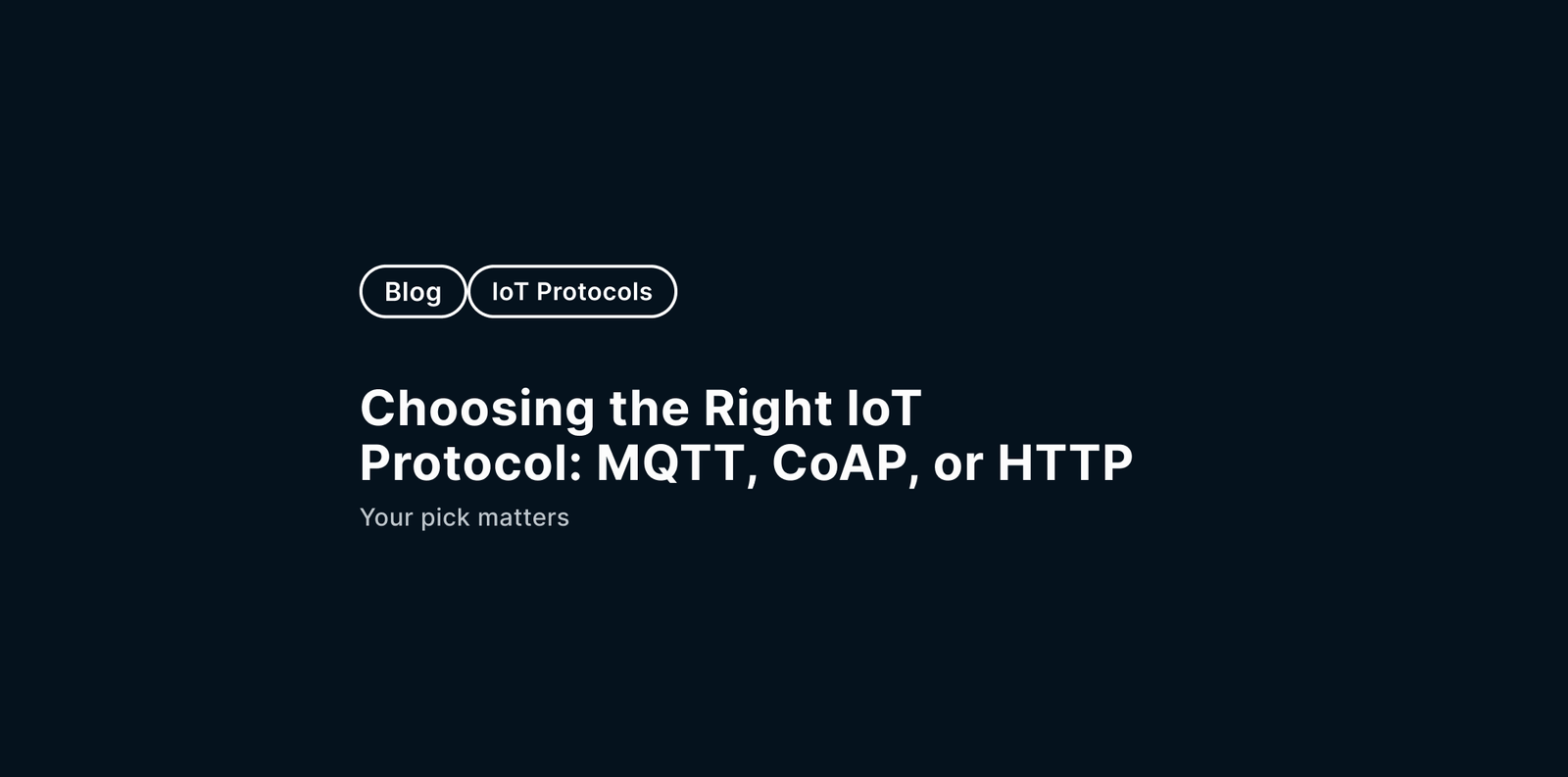✆ + 1-646-235-9076 ⏱ Mon - Fri: 24h/day
Choosing the Right IoT Protocol: MQTT, CoAP, or HTTP


With billions of IoT devices in operation globally, connectivity protocols have become vital in shaping our modern world. IoT devices enhance nearly every aspect of life – from providing comfort in smart homes and enabling automated vehicle control to gathering critical data from factory machinery. They also manage complex city infrastructures, such as traffic lights, and ensure the efficient operation of electric vehicle chargers. Selecting the right communication protocol is crucial for optimizing device performance, reliability, and security in each of these and many other applications.
SmartHome diagram: Kostiantyn Nosachov
Use Cases
Three major protocols dominate the IoT landscape today:
- MQTT (Message Queuing Telemetry Transport): A lightweight, publish-subscribe messaging protocol ideal for real-time communication and low bandwidth environments.
- CoAP (Constrained Application Protocol): A simplified, HTTP-like protocol designed specifically for resource-constrained devices.
- HTTP (Hypertext Transfer Protocol): A widely adopted web protocol suited for more resource-rich IoT devices, frequently used in cloud-based integrations.
Choosing the appropriate protocol depends on device constraints, data volume, latency requirements, and desired reliability and security.
IoT Protocols
MQTT (Message Queuing Telemetry Transport)
MQTT is a lightweight messaging protocol built around a publish-subscribe (pub/sub) model. A central broker manages communications, allowing devices to subscribe to specific topics or publish messages.
Pros:
- Extremely lightweight; ideal for devices with limited processing power
- Low bandwidth and battery usage
- Suitable for real-time data exchange and high latency networks
- Built-in Quality of Service (QoS) options (0, 1, 2) for reliable message delivery
Cons:
- Requires central broker; single point of failure risk without clustering
- Limited built-in security; relies on external layers (TLS, authentication)
Use Cases:
- Smart homes (sensor data, alarms)
- Connected vehicles (telemetry, diagnostics)
- Industrial automation (machine status, predictive maintenance)
Popularity Statistics:
- MQTT is currently the most widely adopted protocol, with around 70% of IoT projects implementing MQTT according to recent industry surveys.
CoAP (Constrained Application Protocol)
CoAP is an IoT-focused protocol inspired by HTTP, optimized for constrained environments. It follows a client-server architecture but includes features specifically designed for low-power devices and unreliable networks.
Pros:
- Extremely lightweight, using UDP for faster, simpler communications
- Built-in support for RESTful APIs, making integration straightforward
- Designed for resource-constrained devices and networks
- Efficient for battery-powered devices due to minimal overhead
Cons:
- Less reliable on unstable networks without built-in advanced reliability features
- UDP-based; messages might be lost or duplicated without careful management
Use Cases:
- Environmental sensors (temperature, humidity)
- Smart energy metering (electricity, gas, water)
- Agricultural IoT (soil moisture sensors, irrigation systems)
Popularity Statistics:
- CoAP is widely adopted in industrial IoT, environmental monitoring, and agriculture sectors, but overall popularity remains behind MQTT at approximately 15–20%.
HTTP (Hypertext Transfer Protocol)
HTTP is the traditional protocol underpinning the modern web. It’s reliable, mature, and easily understood, making it suitable for devices with sufficient resources.
Pros:
- Universally supported and easy to integrate with existing web systems
- Mature, secure (via HTTPS), and highly reliable
- Straightforward development due to broad familiarity and tooling availability
Cons:
- Higher bandwidth and power consumption due to text-based messages and connection overhead
- Inefficient for continuous, real-time updates
- Limited scalability for resource-constrained devices
Use Cases:
- High-capacity IoT devices (smart TVs, security cameras)
- Cloud-integrated IoT solutions with abundant resources
- Devices requiring infrequent, reliable data transmissions
Popularity Statistics:
- HTTP remains widely used, especially for cloud-connected, resource-rich IoT applications. Approximately 10–15% of IoT implementations still rely on HTTP.
Protocol Comparison Table
| Feature | MQTT | CoAP | HTTP |
| Architecture | Pub/Sub, Broker | Client-Server | Client-Server |
| Transport Protocol | TCP | UDP | TCP |
| Bandwidth Usage | Low | Very Low | High |
| Latency | Low | Very Low | High |
| Reliability | QoS Levels 0–2 | Confirmable messages | Reliable (TCP) |
| Security | TLS/SSL | DTLS | HTTPS (TLS) |
| Battery Consumption | Low | Very Low | High |
| Popularity (approx.) | ~70% | ~15–20% | ~10–15% |
Integrated Solutions by Fordewind.io
Fordewind.io has successfully completed numerous projects across various IoT sectors – from smart home solutions and vehicle telematics to industrial monitoring and city infrastructure. With deep expertise in MQTT, CoAP, and HTTP protocols, our experienced team can expertly guide your business to the ideal solution tailored specifically to your technical and operational needs. We handle everything from hardware integration and firmware development to custom cloud infrastructure, mobile applications for Android and iOS, etc. Whatever your project requires, Fordewind.io delivers robust, scalable, and secure IoT ecosystems, ensuring your business achieves maximum performance, reliability, and value.
Conclusion
Choosing the best protocol depends heavily on your specific use case:
- Select MQTT if your IoT solution requires low bandwidth, near real-time communications, reliability, and battery efficiency. Ideal for smart homes, automotive telemetry, and industrial monitoring.
- Choose CoAP when deploying highly resource-constrained devices or sensors needing minimal overhead and battery usage. Well-suited for agriculture, environmental monitoring, and smart energy applications.
- Opt for HTTP when your devices have ample resources, higher bandwidth is acceptable, and ease of integration with web-based cloud solutions is paramount. Suitable for cameras, smart home hubs, and cloud-integrated smart devices.
A clear understanding of your device capabilities and application requirements guides the optimal choice of protocol, ensuring efficient, reliable, and secure IoT solutions to make this world better.